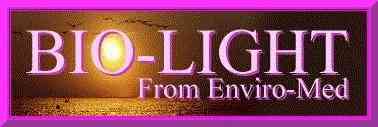 |
Enviro-Med 1600 S.E. 141st Ave. Vancouver, WA 98683 800-222-DAWN 800-222-3296 360-256-6989 |
|---|
| Contents: |
Blue Light: Help or Hazard? |
|---|---|
What About Blue Light?There are many claims for blue light in consumer light products. But does medical research support these claims? What The Experts Say
Leading International ResearchThe Society for Light Treatment and Biological Rhythms is an international organization of researchers and clinicians involved in the field of light therapy. It's members are dedicated to research and clinical applications of light therapy and biological rhythms. The Society states "Early research used special "full-spectrum" bulbs producing light similar in color composition to outdoor daylight, but more recent devices have used ordinary fluorescent bulbs (cool white, warm white, and tri phosphor types) with similar results. (Since full-spectrum bulbs are designed to include ultraviolet light, which might contribute to cataract formation and skin problems, it is best to avoid such light at high intensity unless it has been carefully filtered for UV.) What appears to be critical is that the level of light produced match that of visible light outdoors shortly after sunrise or before sunset. Light intensity is critical for adequate therapy. Systems deliver varying amounts of light, which should be specified in detail by the manufacturer, with information provided as to how far away the patient should sit in order to receive the rated intensity." Concerns over the possible hazards of blue light, which are near the UV portion of the light spectrum prompted the SLTBR to hold a special "Symposium on Safety Issues in the Use of Blue Light" at their 2005 Annual Meeting held in the Netherlands. Cautionary Statements From The LiteratureThe following are quotes from medical journals and scholastic publications. ". . . continuous
exposure to blue light is potentially dangerous to vision."
Koide R, Ueda TN, Dawson WW, Hope GM, Ellis A, Somuelson D, Ueda T,
Iwabuchi S, Fukuda S, Matsuishi M, Yasuhara H, Ozawa T, Armstrong D.
Nippon. Retinal hazard from blue light emitting diode. Ganka Gakkai
Zasshi. 2001 Oct;105(10):687-95. "The high-energy segment
of the visible region (400-500 nm) is enormously more hazardous than
the low energy portion (from 500-700 nm)." Young RW. Solar
Radiation and Age Related Macular Degeneration. Survey of Ophthalmology
1988; 32(4): 252-269. "[The] Action spectrum
for blue-light induced [retinal] damage shows a maximum at 400 nm and
450 nm." Bartlett H, Eperjesi F. A randomized controlled trial
investigating the effect of nutritional supplementation on visual function
in normal, and age-related macular disease affected eyes: design and
methodology. Nutrition Journal 2003, 2:12. "The effectiveness of light in inducing photo damage to the retina increases with decreasing wavelength from 500 to 400 nm." Andley UP,? L.T. Chylack Jr LT. Recent Studies on Photo damage to the Eye with Special Reference to Clinical and Therapeutic Procedures. Photodermatology Photoimmunology and Photomedicine 1990; 7:98-105. "The photoreceptors in the retina . . . are susceptible to damage by light, particularly blue light. The damage can lead to cell death and diseases." Shaban H, Richter C. A2E and blue light in the retina: the paradigm of age-related macular degeneration. Biol Chem 2002 Mar-Apr;383(3-4):537-45. Enviro-Med is a Washington based company providing consulting services, informational talks and research updates. Enviro-Med also designs and markets the BIO-LIGHT brand of light boxes used in clinics, research centers and homes. It's owner, Sherrie Baxter, is a SAD sufferer and user of light therapy. Enviro-Med, 800-222-3296, 360-256-6989, 1600 S.E. 141st Ave., Vancouver, WA 98683 Website: http://www.bio-light.com E-Mail: bio-light@bio-light.com |
|
Bio-Light Bright Light Therapy Systems |
[Contents] [Home] [Therapy] [Lights] [Order] [Articles] [About] [Feedback] [Site Map] DISCLAIMER: Enviro-Med cannot offer medical advice or recommend which individuals should receive light therapy for seasonal affective disorder, winter blues or other conditions. We advise that light therapy for seasonal affective disorder or other conditions be prescribed by a physician or other qualified health care professional and duration and timing supervised by the same. Consult with your physician to rule out any ophthalmological or other conditions that might preclude the use of light therapy. Copyright © 1997 Enviro-Med, www.bio-light.com
|